Tags
"chemistry"
Electric Power Research Institute: Kate Jentoft-Herr, Winter Shadow 2016
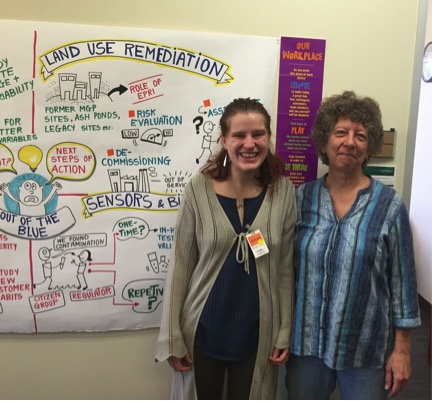
This January I spent a little less than a week shadowing Naomi Goodman at the Electric Power Research Institute in Palo Alto California. I was drawn to this shadow because I wanted a better sense of the kinds of career opportunities that exist for environmental chemists outside of academia. I was also interested in the fact that EPRI receives some of its funding for research from the power industry. I came into this shadow with the hope of understanding if this source of funding could potentially lead to a bias in the types of research that EPRI does.
After spending a week talking to Naomi and her colleagues I now have a much better appreciation for the work that EPRI does. EPRI does research for and receives funding from, a variety of different stakeholders, including their members in the power industry, but also the EPA and some environmental advocacy groups as well. EPRI’s goal is to gather and present data in the most objective, least biased way possible. They do not make policy recommendations or do advocacy work but strive to maintain a reputation of credibility and objectivity that makes them important allies to all third parties that require credible scientific analysis of environmental problems.
Naomi and the rest of the folks at EPRI were incredibly welcoming and hospitable. While I was there I got to have my own cubicle office and I spent most days working on my thesis, going with Naomi to meetings, and meeting with her collogues at EPRI and discussing their work. The people who I met with were, for the most part, project managers and no longer do their own research. They spend most of their time coordinating research projects, analyzing that research, and communicating the findings of that research to the agencies, companies, and other interested parties that are their members. This happens largely via phone calls.
CCD Innovation Food and Beverage Science: Nicholas Egan, Winter Shadow 2016
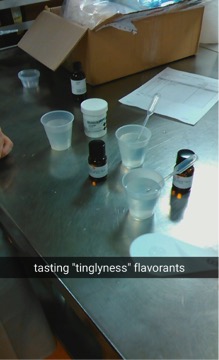
The setup for our tasting experiment
I had not, in my life, expected to be able to point at a bottle of salad dressing at Safeway and say, “Oh cool, I made that.”
(‘Helped make that’ is definitely more proper, but sometimes you’ve just got to flex in the grocery store.)
Applying to CCD Innovation to understand the world of food innovation seemed, in my head, to suppose a certain scientific environment: one comprised of vast numbers of tiny bottles filled with hyper-concentrated-who-knows-what in ultra-sterile laboratories, logbooks filled to the brim with the anguish of hundreds of statisticians in the pursuit of ultimate flavor, and a grim, if regulated, corporate environment with masters of the tastebud denoting the desires of the mass public to lesser, flavoring-affiliated chemists.
Wyle Labs, NASA Ames, Ali Cox, Winter Shadows 2016
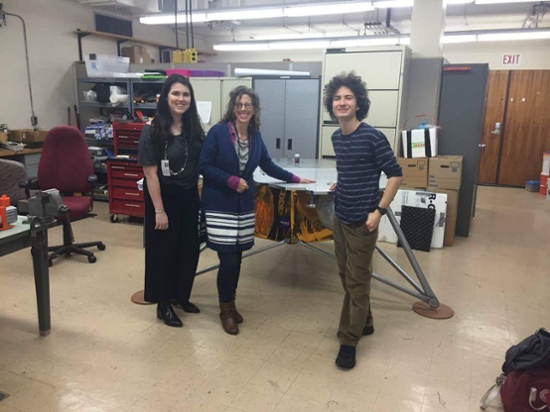
The first day at Nasa Ames Research Center, Arwen showed us her office, where she keeps samples of Mars and Moon dirt analogs (formulated on Earth to resemble as closely as possible the real thing). Apparently these samples are used to test rover instruments to try to determine as best as possible how they would interact with the foreign environment. Arwen also kept pictures of all the previous groups she has worked with on various projects. Among them were a collaboration with the Japanese space agency to build a giant, human-sized centrifuge to simulate the gravity on the moon and on mars, and the construction of the solar panels of the ISS. Arwen showed us a piece of these panels. They were made of an incredibly thin material with intricate circuitry. Apparently when folded the basketball court long panel becomes only 3 inches thick, which I thought was amazing.
After this inspiring first impression of Arwen's job, we attended a meeting on a space station bio-lab Arwen's team is working on. Though there was a lot of technical talk that I didn't understand, I felt the vibe of teamwork and enthusiasm.
Many of Arwen's colleagues work on side projects with a different group of people out of their own interests. One of Arwen's side projects is a new Mars lander whose main goal is to directly search for life using a big drill, unlike previous rovers, which were apparently more concerned with geology. We got to see the life-sized wooden model of this lander built by Dave, a spacecraft expert. Dave was also nice enough to give us a tour of an ancient Titan 1 rocket. He even gave hand-outs about rocket engine principles and the many different types of rocket engines!
Continue reading Wyle Labs, NASA Ames, Ali Cox, Winter Shadows 2016
Green Molecules and Green Chemistry Labs, Part III
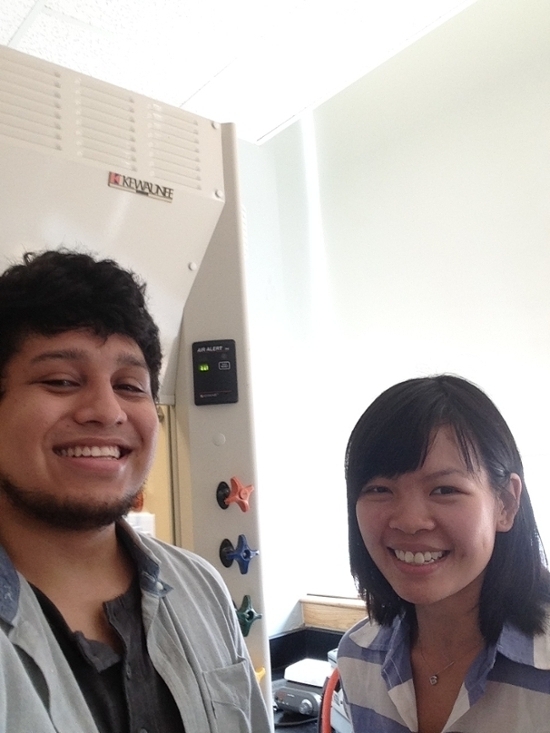
Johnny and Cindy.
It’s been two weeks since my last day at the lab. The time I’ve spent away has given me a different perspective on how I spent my summer.
The things I learned have made me fall in love with chemistry all over again. Solid-state synthesis, gas-phase-synthesis, ionic liquids, phase-transfer catalysis, macrocycle synthesis, these terms have gained new meaning since I had first read about them in a textbook in May (it seems so long ago).
The Aldol condensation is already a green organic chemistry reaction: it has high atom-efficiency and produces water as a byproduct.
Continue reading Green Molecules and Green Chemistry Labs, Part III
Off Quad Rule: Part 9
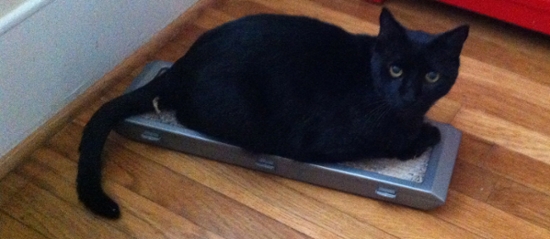
Rooibos
After a week of writing up a precise yet thorough protocol, I am getting to unwind after all the unpacking and driving. It took a few showers and a haircut to really feel like I got that signature ‘wet-lab’ film off, but I am finally back at home grazing and keeping cool.
Continue reading Off Quad Rule: Part 9
Off Quad Rule: Part 8
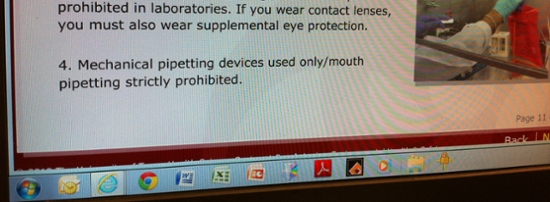
Tehina and Pita
There it is, no mouth pipetting… Sorry Makotes. After a good lab evaluation and fresh samples coming in, the few let downs stemming from the cannabinoid project are hardly felt. At the moment there are some technical difficulties being sorted out since I have been getting a signal of cAMP production when I don’t think I should be. Now I’m investigating a cAMP baseline for the lymphocytes I’m testing for comparison. The good news is that this is somewhat expected since I’ve moved on from the forskolin curve to also running the full agonist drug simultaneously with the forskolin and ATP, a new element to the complicated mix. One step forward, three or five back.
Ful Medames
This week has been super busy, the consequences of the power outage are slowly surfacing as I go about trying to use machines that have switched back to their manufacture default settings. They still work, there’s just a touch more tinkering around that adds up as the day passes along. This week more mouse brain samples arrived for tissue collecting and homogenizing. I finally got a clear picture of them to show you all, the worker making the extractions was excellent.
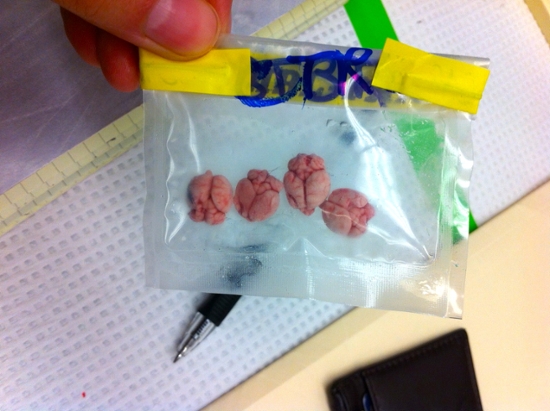 Figure 1. Mouse brains – 4 count. Don’t they look like candy? They’re also hard as rocks from bathing in liquid nitrogen. My thumb for scale, which is already small.
Figure 1. Mouse brains – 4 count. Don’t they look like candy? They’re also hard as rocks from bathing in liquid nitrogen. My thumb for scale, which is already small.
Continue reading Off Quad Rule: Part 8
Green Molecules and Green Chemistry Labs, Part II
Summer snuck up behind me. Before I knew it, high school graduation was here, school was out, and with it, most of the students and teachers who normally populate the Bard Queens hallways I’ve roamed and reacquainted myself with.
One of the first things I was told to expect about the PSF project was to be ready for surprises, and to be ready to take things in stride. Even so, when the end of June approached, I panicked. I knew I couldn’t work in the lab without a supervisor, and knew that Julia would be leaving for China come the last week of school. I hadn’t begun working in the lab until the start of June, since working here required permission from the NYC DOE (bureaucracy has a funny way of stifling creativity). School duties (proctoring, chaperoning, etc.) kept Julia and Cindy busy for a few days, and migraine attacks kept me from the lab once they were back and ready to go. After working in the lab for two weeks, and a cumulative one-week absence, I found myself with a notebook full of ideas but no time left to act them out. I performed what I could and got ready to say goodbye, disappointed that June had come and gone with the wind.
Right before she left, Julia mentioned that Cindy, the lab teaching assistant, was willing to work with me over the summer. Still, she admitted that this rested on its acceptance by the powers that be. I gave her a gift, hugged her, said goodbye, and thanked her for all she had done for me. I waited. Then, ecstasy! Cindy said she would be in the lab, and that I was welcome to pass by anytime.
Continue reading Green Molecules and Green Chemistry Labs, Part II
Off Quad Rule: Part 7
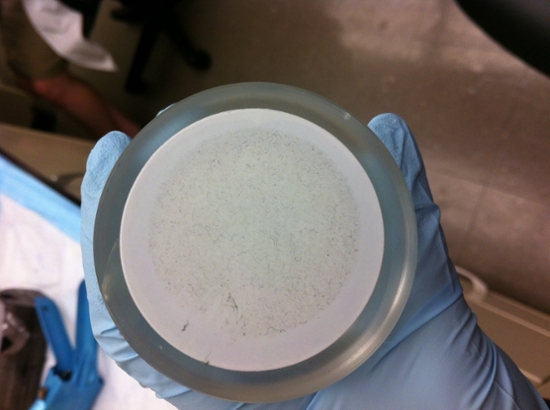
Alecha
The picture to the right is a PSA to remind people to always use protection and filter. Gross, am I right? This week has been filled with me fiddling and peddling around the lab, sometimes in the dark due to the power outage that plagued the research labs and hospital facilities. There is a lab evaluation next week so I won’t have as much time to work on my project and write out as many quick notes and passages to you. It seems that when you need everything to work perfectly it breaks down and throws a tantrum. The HPLC and GC-MS, gas chromatography mass spec, machines are having quite a fit. It’s like the power outage woke up a bunch of cranky toddlers, and believe me, dear reader, they are not crib happy.
Continue reading Off Quad Rule: Part 7
Off Quad Rule: Part 6
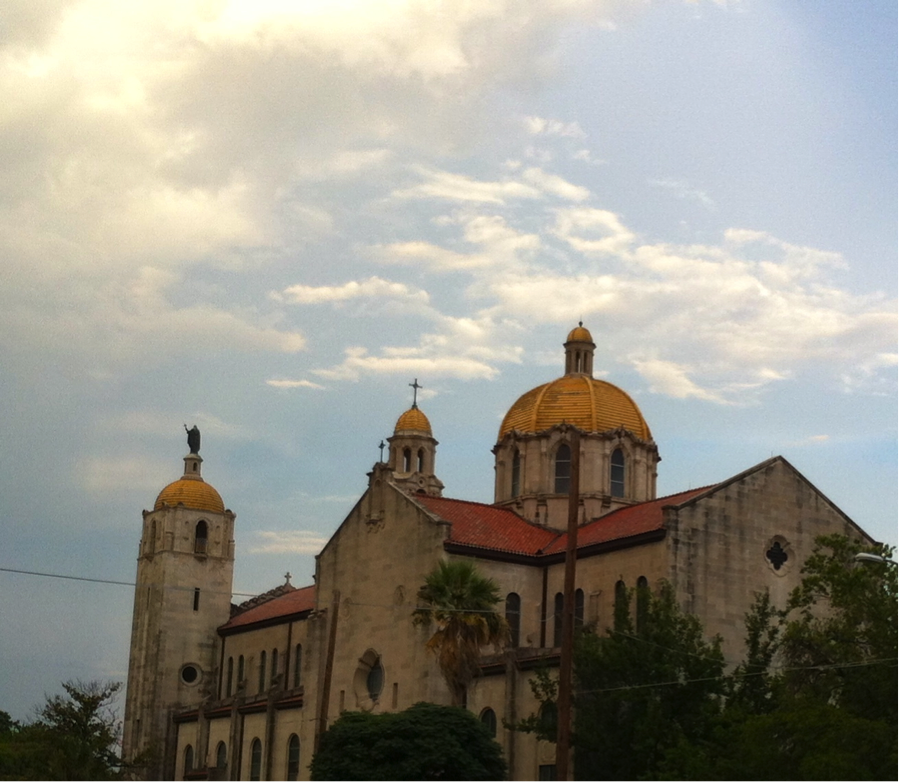
Handkäse mit Musik
Pictured here is La Pequeña Flora, The Little Flower. It’s a church tucked away in a residential area that I happened upon. There are tons of old religious structures in San Antonio, I thought I would share my favorite one with you guys. Touring this was better than seeing the Alamo in my opinion. This week was quite eventful, with a human brain dissection and the chemicals for the ELISA kit I’m working on coming in. I also want to give a huge thank you to all of you sending me letters, the mailman here now knows me by my name due to the abnormal volume of mail I receive that isn’t just bills. As I finish off the final steps in the newest protocol (fingers-crossed) I wish the rest of you much luck with the projects and endeavors you’re tackling this summer. Let’s go Deutschland.
Continue reading Off Quad Rule: Part 6
Off Quad Rule: Part 5
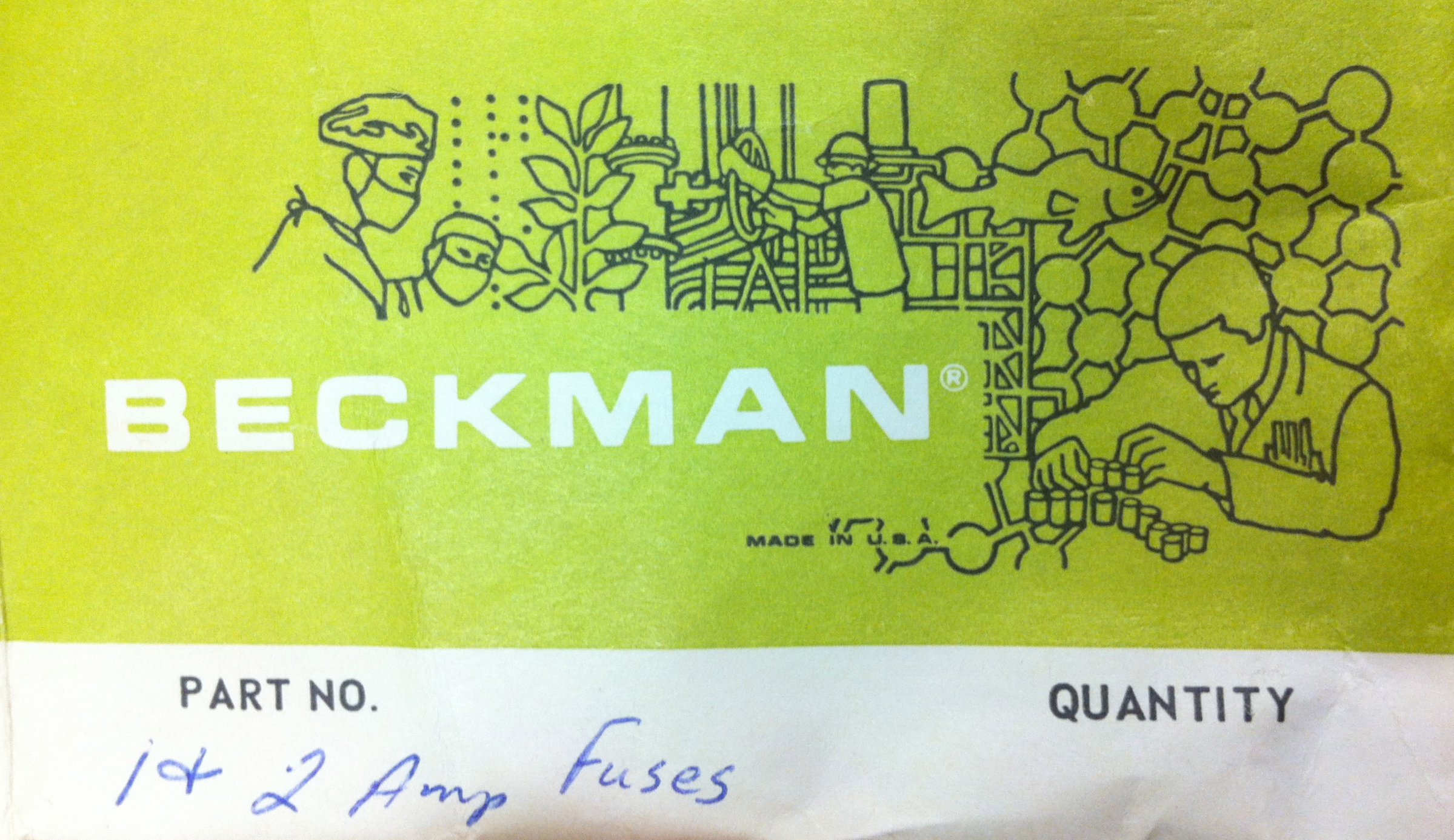
Mezes & Dakos
Happy Fourth! I hope you get to eat some good grilled food, dance among fireflies, and have your fair share of fireworks that aren’t your neighbors annoying second-rate cacophony of explosions tonight. Despite the first new curve analysis, which is promising (R2 = 0.998 for the lymphocyte protein curve, that is, what we think is in the samples, is in the samples), the THC project is currently on hold. There are high hopes of the new sample sets working with the ELISA enzyme assay kit, however due to unfortunate circumstances not all the necessary materials have arrived for round two (after all not every company can do -20°C overnight shipping like Sigma-Aldrich – it’s rather sketchy how that kind of transport it legal).
Spetsofai
Continue reading Off Quad Rule: Part 5
Off Quad Rule: Part 4
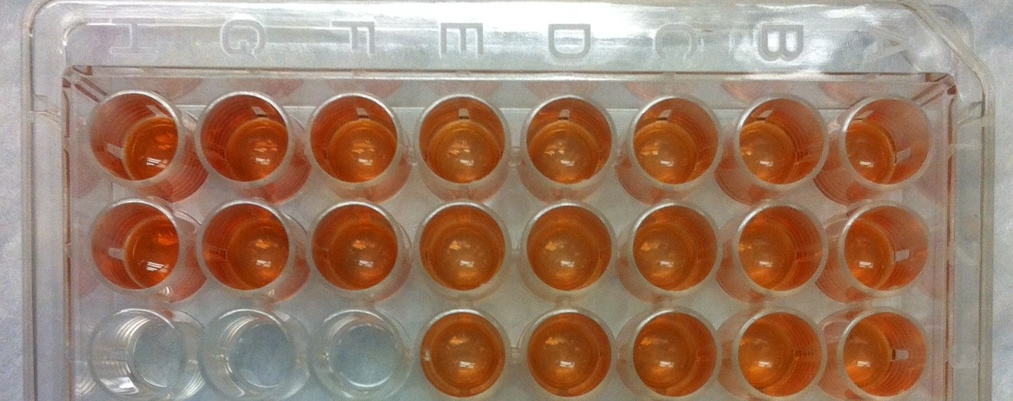
Mestouf
Another day another dollar, a new week a new protocol. I got to explore a revised protocol for harvesting lymphocytes from blood, which was as much fun as it was frustrating. I also got to learn a little about Rapamycin and its antibiotic properties – it happens to change the color of muscle from the typical fleshy red to a still very natural goldfish orange when applied to open wounds. I recently found a good centrifuge companion to fill the time when I actually have 30 minutes to spare during my busy day; Donna Tartt’s The Goldfinch has been a good read so far.
Continue reading Off Quad Rule: Part 4
Green Molecules and Green Chemistry Labs: Johnny Mendoza, PSF Summer Experience
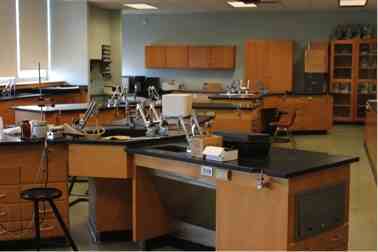
The last time I had been in this chemistry lab was 2 years ago. Back then, I was just getting my feet wet in the field of organic chemistry with the aid and guidance of my professor, Julia Robinson-Surry (’06). Now, I’m working with Julia and the lab teaching assistant, Cindy Liu, to dive deep into the field of green chemistry. With their help, I plan on revamping the current organic chemistry lab curriculum at Bard High School Early College Queens, my old high-school, in an attempt to make it more environmentally-friendly. In addition, I hope to learn about the role and synthesis of green catalysts in organic chemistry, specifically Julia’s work with Fe-TAMLs, a group of oxidation catalysts that has proven useful in environmental cleanup efforts.
Bard Queens is a small school. With 600 students on two floors, it didn’t always feel that way, but the average class size is 20 students. It is also a new school, at only 6 years of age. This comes with some inherent difficulties. For example, the chemistry lab at Bard is not as well endowed as Reed’s. For one thing, there are only two fume hoods, one of which is not working. The only way these chemistry students can characterize their product is through infrared spectroscopy (IR) or physical analysis (i.e. matter state, melting point, boiling point, chemical assays, etc.). In most organic chemistry labs, nuclear magnetic resonance spectroscopy (NMR) and gas chromatography–mass spectrometry (GC-MS) are standard analytical methods. Our project must keep these limitations in mind, and design labs that can be preformed mostly on the bench-tops, while avoiding volatile/strong-smelling chemicals and synthesizing products that can be differentiated readily from any reagents used.
Bard Queens also employs a relatively unique curriculum, where the first two years of school are dedicated to fulfilling high-school requirements and the last two years dedicated to taking college courses with the goal of graduating with an associate’s degree. The students taking organic chemistry here are generally 2 years younger than those at other colleges. The lab periods are also shorter (2 hours, 40 mins vs. 4 hours at Reed). One of our goals will be to make these labs accessible yet rigorous, worthwhile yet not time-consuming, and above all, interesting.
